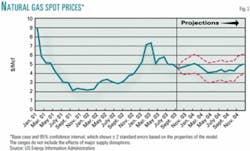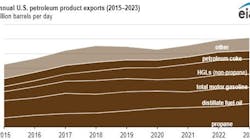Assuming normal weather patterns in the US, winter fuel prices this year will stay the same as last year for households that use heating oil and propane, the US Energy Information Administration predicted Oct. 7. But for natural gas residential customers there is a different story: tight supplies mean consumers can expect prices 9% higher than the previous year, and severe weather could push prices much higher, according to the agency's latest winter fuel forecast.
The EIA forecast predicts fuel market conditions from Oct. 1 through Mar. 30.
Normal weather, slightly softer demand, and healthy inventories could keep prices relatively stable this winter, the agency said. Nevertheless, cold weather could generate price spikes, the agency warned.
While the gas storage picture has definitely improved, US oil and gas markets remain tight, as indicated by relatively high prices for crude oil and gas, low domestic stocks of crude oil, and relatively low petroleum stocks throughout industrialized countries, according to EIA forecasters.
"Because of the general tightness of domestic oil and natural gas markets, which is likely to continue throughout the winter, there would be a strong upward price risk for heating oil as well as other fuels if winter temperatures fall well below normal," EIA said.
The risk of higher fuel prices under a colder-than-normal winter scenario is "substantial," EIA said. If heating degree days are 10% higher than normal, national average residential prices for heating fuels would be expected to exceed the normal weather case by about 6% for heating oil, 5% for natural gas, and 8% for propane. Household heating expenditures would then rise 17% for heating oil, 16% for natural gas, and 19% for propane.
Oil projections
EIA's outlook for world oil prices remains near $30/bbl (West Texas Intermediate) for the coming months and the winter of 2003-04. The agency said the Organization of Petroleum Exporting Countries' decision to cut its production targets reduces the chances for an end-of-year stock build.
"Even before OPEC's decision to lower quotas, EIA had projected that the Organization for Economic Cooperation and Development commercial inventory situation would remain tight until the end of the year," EIA said.
Until these inventories are rebuilt above observed 5-year lows, (which is not expected to occur until at least early 2004), WTI prices should remain firm, then gradually slide to roughly $27/bbl by late 2004 (Fig. 1).
In 2003, total US petroleum demand is projected to increase by 170,000 b/d from last year's average, or by 0.9%, to 19.94 million b/d. Demand growth for individual products, however, is expected to vary widely. Total 2004 petroleum demand is projected to grow by 420,000 b/d, or 2.1%, to an average 20.35 million b/d.
EIA predicted that all the major products (except residual fuel oil) would contribute to that growth. They cited "a general improvement in economic conditions but also a belated recovery in demand for jet fuel and liquefied petroleum gas from 2003."
Meanwhile, natural gas demand is expected to fall by 1.1% in 2003 due mainly to high prices discouraging demand, particularly in the industrial and power sectors. A 0.6% increase in consumption projected for 2004 is attributed to accelerated economic growth and generally lower prices (Fig. 2).



